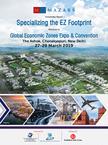Specializing the EZ Footprint
The establishment of Global Economic Zones, or namely Special Economic Zones, has been a time-tested framework for undertaking streamlined production & trade in a host of different nations. It facilitates countries to employ the right balance of national control and international liberalization in designated economic power-hubs, driving in largescale investment, employment and cross-border commerce, for the entire region.
India has undoubtedly been an early EZ adopter, from its first EPZ in Kandla making the mark in 1965, to the radical shift towards a structured SEZ regime brought about in the early 2000s. Domestic economic zones have therein mushroomed throughout the country, with over 355 notified zones to date, out which 231 stand operational. These have essentially become economic sparkplugs towards increased FDI, production, exports, jobs and infrastructural development, which are well-aligned with the ongoing Make-in-India, Digital-India and Skill-India objectives. This can fuel in greater benefits ahead, helping India develop strategic & synergistic ties on a global level.
While debates surrounding the recent imposition of MAT and DDT, as well as the hovering income tax sunset, have created inherent market speculation, they should not undermine the future of Indian SEZs. Rather, stability should be brought about by putting forward a clearer regulatory regime that gels well on both the local and global front, as well as fixing up impending bottlenecks across the value chain. This should, as per the recent Baba Kalyani Committee report, ideally transform domestic zones into Employment & Economic Enclaves.
Mazars believes a possible way forward for such transformation lies in taking a Creative, Collaborative and Connected approach, which focuses on creating a balanced incentive bucket that instills competitivity, collaborating with a variety of stakeholders that curbs incongruity and connecting displaced zones – both geographically and digitally – through a robust logistical network that enhances efficiency. The key is not to cut out but rather upgrade the current SEZ ecosystem, which encourages robust knowledge-sharing and expertise for the next round of economic growth.
Explore and download the complete report.

